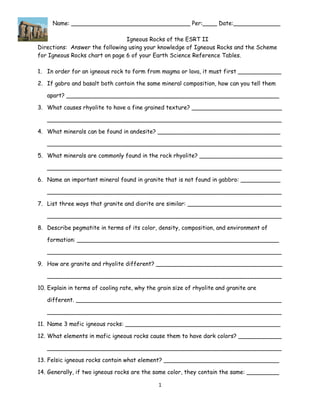
Igneous rocks of the esrt ii
- 1. Name: _________________________________ Per:____ Date:_____________ Igneous Rocks of the ESRT II Directions: Answer the following using your knowledge of Igneous Rocks and the Scheme for Igneous Rocks chart on page 6 of your Earth Science Reference Tables. 1. In order for an igneous rock to form from magma or lava, it must first ____________ 2. If gabro and basalt both contain the same mineral composition, how can you tell them apart? ___________________________________________________________ 3. What causes rhyolite to have a fine grained texture? _________________________ _________________________________________________________________ 4. What minerals can be found in andesite? __________________________________ _________________________________________________________________ 5. What minerals are commonly found in the rock rhyolite? _______________________ _________________________________________________________________ 6. Name an important mineral found in granite that is not found in gabbro: ___________ _________________________________________________________________ 7. List three ways that granite and diorite are similar: __________________________ _________________________________________________________________ 8. Describe pegmatite in terms of its color, density, composition, and environment of formation: ________________________________________________________ _________________________________________________________________ 9. How are granite and rhyolite different? ___________________________________ _________________________________________________________________ 10. Explain in terms of cooling rate, why the grain size of rhyolite and granite are different. _________________________________________________________ _________________________________________________________________ 11. Name 3 mafic igneous rocks: ___________________________________________ 12. What elements in mafic igneous rocks cause them to have dark colors? ____________ _________________________________________________________________ 13. Felsic igneous rocks contain what element? ________________________________ 14. Generally, if two igneous rocks are the same color, they contain the same: _________ 1
- 2. _________________________________________________________________ 15. What determines the grain size and texture of an igneous rock? _________________ _________________________________________________________________ 16. An igneous rock is found to contain 50% potassium feldspar, has mineral crystals ranging in size from 5-7 mm. What is the name of this rock? ___________________ 17. A felsic igneous rock has a glassy texture and a black color. What is the name of this rock? ____________________________________________________________ 18. Which intrusive igneous rock could be composed of approximately 60% pyroxene, 25% plagioclase feldspar, 10% olivine, and 5% amphibole? __________________________ 19. An extrusive igneous rock with a mineral composition of 35% quartz, 35% potassium feldspar, 15% plagioclase feldspar, 10% biotite, and 5% amphibole is called _________ 20. A fine-grained igneous rock composed mostly of plagioclase feldspar and hornblende and containing no quartz or pyroxene would be classified as ____________________ 21. A sample of vesicular andesite was found to be 20% amphibole. What is the percent composition of the other minerals present? ________________________________ _________________________________________________________________ 22. A sample of gabbro contains 5% biotite. What is the percent composition of the other minerals present in this sample? ________________________________________ _________________________________________________________________ 23. A sample of granite is found to contain 20% plagioclase feldspar. Determine the composition of the other minerals present in this sample. ______________________ _________________________________________________________________ 24. A sample of diorite is 55% plagioclase feldspar. What percentage of this rock is biotite? _______ How much of this rock is amphibole? __________ How much of the sample is quartz? _______ 25. The picture below shows the igneous rock obsidian. 2
- 3. The obsidian's glassy texture indicates that it formed from a magma that cooled (1) slowly, deep below Earth's surface (2) slowly, on Earth's surface (3) quickly, deep below Earth's surface (4) quickly, on Earth's surface 26. Biotite mica and muscovite mica have different chemical compositions. Compared to the magma from which biotite mica forms, the magma from which muscovite mica forms is usually (1) more mafic and less dense (2) more mafic and more dense (3) more felsic and less dense (4) more felsic and more dense 27. Which process could lead directly to the formation of pumice rock? (1) precipitation of minerals from evaporating seawater (2) metamorphism of unmelted rock material (3) deposition of quartz sand (4) explosive eruption of lava from a volcano 28. The diagrams below show the crystals of four different rocks viewed through the same hand lens. Which crystals most likely formed from molten material that cooled and solidified most rapidly? 3
- 4. 29. The photograph below shows actual crystal sizes in a light-colored igneous rock that contains several minerals, including potassium feldspar, quartz, and biotite mica. Name this rock. ______________ 30. Explain how you know this intrusive igneous rock cooled slowly. _________________________________________________________________ 4